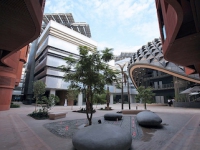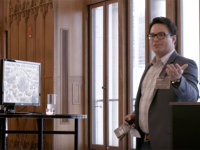The climate and construction codes are changing in a drastic way. We are beginning to hear about building codes around the world that demand that all buildings built by a certain date, whether that is 2025 or 2030, be zero carbon or have zero carbon emissions. This is critical in China where the air quality is questionable on even the best days. Japan is also instituting those rules to provide for the future of their countrymen.The United Arab Emirates, however, got what they thought was a jump on the world when, in 2006, the government commissioned Lord Norman Foster and his team to build the first pilot “Zero Carbon Emission” city to be known as Masdar or “Source.” It was designed and planned to create a leading edge city for 50,000 in the desert on the outskirts of Abu Dhabi near the airport. Lord Foster planned for it to become a template for other “Zero Carbon” cities around the world.
Those sounds you hear are the screams of agony emanating from the labor unions in the construction industry in New York City. For the first time in recent history, three major contractors, Turner, Tishman and Plaza Construction have joined with several lesser-known companies to open their private sector sites to non-union labor.This is a move that, in the recent past, would not have been considered on commercial and residential projects in New York, long a hotbed of union labor in the construction unions. This is an especially critical change in a market like New York City where densities and construction rules for both public and private sector projects have long mandated that construction workers on the major sites must have apprentice training in order to be employed.According to a recent article in the Wall Street Journal titled “Construction Unions’ Grip on New York Begins to Show Cracks” states that the major construction firms have declined “to renew collective bargaining agreements with unions, opening the door for more non-union workers and sending the clearest signal yet that once mighty construction trade groups are losing their grip on private-sector construction work.”
June 22, 2016
It was noted just the other day in The Guardian that in London, home to many major multinationals and a key player in the European Union, there are 436 planned buildings that will be over 20 stories tall. Eighty-nine are currently under construction and the 233 approved proposed buildings in the pipeline have more than doubled in the last year.In the overall London approval process that is similarly economically driven like Houston, but still at least 10 times tougher, only 3 buildings have been denied approval for construction. There are on-going debates about the clustering of the towers, sight lines to St. Paul’s Cathedral, shadow patterns on nearby buildings, and wind tunnels created by the buildings. However, once a building has been approved, its development is dependent on the financing of the scheme.
June 10, 2016
Recently, Builtworlds, one of our favorite sites, hosted a Con Tech Forum in Chicago bringing together “national industry thought leaders and change agents for a high-impact, collaborative event that will deepen attendees’ understanding of the unprecedented power and possibilities now available to those who design, build, operate, maintain, plan and trade in our vital, evolving $7-trillion industry.”The “C suite” only conference held at the Chicago Athletic Association was 48 hours of jam-packed “forward looking information” for executives in construction. The conference speakers touched on a wide variety of lively subjects and hands on experiences that included:Wearables (headsets, helmets, armbands, etc.); Robotics; Modular Construction; Apps for Safety, Reporting, Documentation, Collaboration; Unmanned Aerial Vehicles (drones);
May 31, 2016
I recently wrote about the technologies that are disrupters and in the early stages of development. One of the first that we will see in the construction industry is 3D printing.Most forward thinking contractors and subs are becoming aware of this phrase while designers are incorporating 3D printing into their designs in other parts of the globe. We wrote about the 3D printed houses in China, but that is not the only place where the leadership intends to incorporate this disrupter into their way of life.One key country that intends to embrace 3D printing is the UAE, specifically Dubai, and the leadership there is making a giant leap to incorporate the technology, as Inside 3D has reported, Sheikh Mohammed has announced the Dubai Future Agenda.
May 10, 2016
According to Construction Dive, CNBC reports that Goldman Sachs recently released a report that states that in the residential construction industry, there is no labor shortage. In fact, the report says that since the payroll labor rates have not gone up at high enough rates to meet their criteria, there is no shortage at all."Economics 101 would suggest that, if labor shortages did in fact exist, upward pressure on wages would be more pronounced and payroll growth would be anemic," the report said. "Therefore, the evidence from the industry-level employment and wage data does not support the existence of labor shortages in the construction sector."The post points to a report from John Burns Consulting, which surveyed over 100 homebuilders, which states, according to both CNBC and Construction Dive, that the lackluster performance is due to the lack of available development land and major delays in obtaining construction permits.
May 04, 2016
Kollaer offers the following advice to company owners: “No matter what the conditions, never ask your crews to wear PPE and then put yourself in a hazardous position without doing it yourself.”
April 25, 2016
In a recent post, I mentioned the major disruptors that are afoot in the architecture, engineering and construction industry. I presented them recently to a subcontractor group and illustrated ways that these disruptors would reshape the AEC business that we have known for our entire careers.One of those disruptors that I mentioned was the 3D printer. The example I used was in China where the contractors printed houses, 10 of them built in 24 hours, as a prototype for potential housing for the thousands of Chinese moving from the countryside into the cities.
April 18, 2016
The job is finished on time and under budget. The punch list was minor. There were no claims and the retention was paid as expected. The contracting team and subs made a decent margin on a project that required some innovative structural systems and finishes. The project was a success for the contractor. Right?The project was finished on time and under budget. The design was groundbreaking and is likely to be an award winner for the global design team, one that had been awarded the design over a myriad of global design stars. The building has been commissioned and the invoices paid. The project was a success for the architects. Right?
April 15, 2016
Last week I attended the last day of the 2016 Rowlett Lecture Series at the Bush Library at Texas A&M in College Station. It was a two-day affair that celebrated the 25th anniversary of the CRS Center. CRS (Caudill Rowlett Scott) was a legendary global architecture firm that started at College Station in the 1940s. Its principals taught hundreds, if not thousands, of architects and engineers Architecture By Team and Problem Seeking, processes that are still used by firms across the globe today. The CRS Center houses the historical documents and books that were produced by the firm.The firm and the multitude of professionals who worked on the CRS team were "Disrupters" of the profession, and it is no wonder that those CRS processes have morphed and are being used by architectural firms in the development of complex buildings and campuses today.I was fortunate to have played on the CRS team first as a programmer and later as the Director of Marketing. I went to hear the latest iteration of the application of the CRS Problem Seeking methodology on projects and to see many of my former colleagues and friends.One of the feature presentations was by Scott Simpson, FAIA and Senior Principal at the Greenway Group and Editor at Large of Design Intelligence. His talk, about the length of a TED talk, touched on the future of the architectural profession and he flashed a slide of the "Disrupters" of the design profession, those that will have a profound impact on the architects and the designs of the future.
April 11, 2016






















